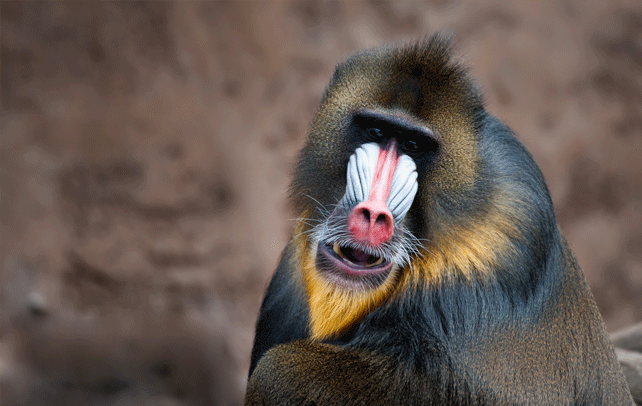Amazing Facts About Mandrill

“No other member in the whole class of mammals is coloured in so extraordinary a manner as the adult male mandrills”—Chales Darwin
Red and blue coloured nose and multi-coloured back of mandrills make them the most attractive and beautiful creatures in the cercopithecidae family. Although their bright colours attract more attention and make them stand apart from other monkeys, their furry head crests, manes, and beards are also impressive. Male mandrills are more colourful and beautiful than their female counterparts as they have peculiar coloured noses and rumps while the females have dull parts. These colourful creatures are the inhabitants of tropical jungles in western central Africa. Female mandrills live in a large group while the male mandrills prefer to live alone except during the mating season. Read the subsection and collect some more information about mandrills.
Fast Facts
Scientific Name: Mandrillus sphinx
Kingdom: Animalia
Phylum: Chordata
Class: Mammalia
Order: Primates
Family: Cercopithecidae
Species: M. sphinx
Diet: Fruits, roots, and animals such as insects, reptiles, and amphibians
Size: Body: 22 to 33 inches; Tail: 2 to 3 inches
Weight: 11.5 to 30 kg
Life Span: 40 years in wild and 46 years in captivity
Natural Habitat: Tropical rainforests
Call: Roars, crowing, screams and grinds
Age of Maturity: 4 to 8 years
Gestation Period: 6 to 7 months
Number of Offspring: 1
Interesting And Fun Facts About Mandrill
- Mandrills are found in tropical rainforests and sometimes grasslands of Southern Cameroon, Gabon, Equatorial Guinea, and Congo.
- Being the primate of the old world monkey family, they are believed to be closely related to great apes, but actually they belong to the baboons. Recent studies have revealed that mandrill population along north and south of Ogooué River is genetically different and they can be put into two different subspecies categories.
- Mandrills are the world’s largest monkeys, measuring 3 feet in height and weighing between 25 to 35 kilograms.
- Leopards, snakes, and birds of prey are their predators. The birds of prey usually attack the young ones of mandrills.
- They have an omnivorous diet which consists of fruits, leaves, lianas, bark, stems, fibres, ants, beetles, tortoise, frogs, porcupines, rats, shrews, and small antelopes.
- A study revealed that the diet of one mandrill consists of 50.7% fruit, 26.0% seeds, 8.2% leaves, 6.8% pith, 2.7% flowers, 4.1% animal foods, and 1.4% other food items.
- Being social creatures, mandrills like to be the part of large and stable groups, called hordes. The strength of hordes cannot be identified easily and accurately, but it is estimated that there can be 625 to 845 mandrills in a horde.
- The largest mandrill group, found in Lopé National Park, Gabon, had 1300 individuals. It is the biggest non-human primate gathering ever recorded.
- The hordes mainly consist of females and their young ones as the males like to live solitary life, but they join the group during the mating period, which is from June to October.
- The brightly coloured and fatted dominant males and the paler and nonfatted subordinate males are the two different forms of adult males. From these two types only the former ones succeed in bringing up an offspring
- The babies of mandrills are pink in colour with a black coat. They have fur on their body and their eyes are open at the time of birth.
- Babies cling to their mother’s stomach and can support their own weight. Mandrills create a strong bond with their daughters as compared to sons.
- Usually females give birth to single baby and twins are rarely born. Infants weigh around one to two pounds and at about two months of age they lose their baby hair in order to grow adult coat.
- Just like human beings, all the female members of the family like, mothers, aunts, and sisters take care of the offspring. The mother provides nourishment and grooming while others play with the baby and protect it when the mother is off for food search.
- Identifying these extremely colourful animals from a distance is very easy as they have olive green or dark grey body with yellow and black bands and a white tummy.
- Their hairless face has an extended muzzle with red stripes in the middle and blue rims on the sides. Along with muzzle, their lips and nostrils are also red in colour.
- A yellow beard and white tuffs give them the look of a wise old man. The area below the stomach can have red, pink, scarlet, blue, or purple colour.
- They have almost 6.5 cm long canine teeth that are used for self defence and to intimidate enemies. They are also known to expose their teeth amongst themselves as a gesture of excitement.
- Mandrills are adaptable to moving on the ground and jumping on the trees. They use their knuckles present on the forelimbs to walk and on trees they move by jumping sideways.
- These diurnal creatures stay on land in the daytime and sleep on trees at night, but they change their sleeping area every night.
- They communicate through scent markings, vocalization, and body gestures. Males have cutaneous (skin) glands and sternal glands in the middle of the chest which they use for scent marking.
- Currently, these species are at the vulnerable stage of survival. Hunting, deforestation, and human settlements are the main reasons behind it. They often become the meal of African people and are also hunted as bushmeat.
- They are highly social animals but still you can’t domesticate them.
- One can easily identify the mood of a mandrill with the help of its gestures. Mandrill is excited when it exposes its teeth and shakes its head, but when it stares and slaps the ground then it depicts aggression.









